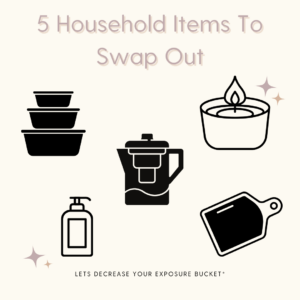Some common home items may actually contribute to our health problems. From kitchenware to skincare, to homeware, many products bring unwanted chemicals into our homes. These synthetic chemicals that can be absorbed through the skin, inhaled, or ingested. Long-term exposure to these chemicals can contribute to chronic health conditions like respiratory issues, hormonal disruptions, skin issues, and neurological problems. Keep reading to start building your non-toxic home.
Our Toxin Bucket
The fact is that toxins exist in our environment. Our exposure will never be zero. However, when we are exposed to a high amount of toxins or have difficulty detoxing them (due to genetics or vitamin deficiencies), our “toxin bucket” starts to overflow. An overflow of this metaphorical bucket translates to physical symptoms in the body.
While we can’t control all the factors contributing to our toxin bucket, one way to decrease our toxin exposure is to slowly replace home items for more natural, chemical-free, non-toxic alternatives.
Remember that these changes do not need to be immediate and perfect; they can be done gradually. Health is always about taking it one step at a time.
Five everyday household items to swap:
1. Plastic Tupperware –> Glass Tupperware
Grab all of the old plastic containers taking up space in our kitchen drawers and switch them out for glass tupperware! Glass is free of BPA and phthalates. BPA is Bisphenol A, which is a chemical that is found in hard, clear plastics. Phthalates are used to make soft, flexible plastics. These two chemical compounds found in most plastic tupperware can potentially leach into our food, especially when exposed to heat (like in microwaves). Studies have shown that phthalates may increase allergies and BPA may cause behavior changes in children. Glass on the other hand, is non-toxic and will not leach these potentially harmful substances into your food so they are the safer option.
2. Synthetic Body Soap & Lotions –> Natural Soap & Lotions
When it comes to opting for better skincare products, start with body soap and body lotion. These are used in the most amount over the whole body. Most conventional soaps and lotions contain synthetic additives, fragrances, and preservatives that may cause irritation or allergic reactions in some individuals. More natural skincare products may aim to reduce exposure to these potentially harsh substances. The natural alternatives will be especially beneficial to people with eczema, dermatitis, psoriasis, rashes, acne, and rosacea.
Here’s a link to natural, “chemical-free” soaps and lotions that you may like:
3. Plastic Cutting Boards –> Rubber, Glass, Wood Cutting Boards
Like plastic tupperware, plastic cutting boards may also have harmful chemicals like BPA and phthalates. When we cut and prepare our foods on plastic cutting boards, small microplastics may mix into our food. Swap out plastic cutting boards for 100% natural rubber, glass, or wood cutting boards to avoid these microplastics.
4. Synthetic Candles –> Soy Wax Candles
We know it’s fun to go to Target or TJ Maxx and grab every delicious-smelling candle we see, but unfortunately, most of those candles are synthetic and can disrupt your health. Synthetic candles are mostly made with petroleum-based waxes like paraffin and contain other chemicals like phthalates and fragrances. Burning these candles leads us to inhale these chemicals, which can contribute to allergic symptoms, asthma, and altered hormone levels. Switching to soy wax candles with more natural sources of scents makes for a healthier option for people who may have sensitivities or respiratory issues. Soy wax also has a lower melting point than paraffin wax so it will last longer and be more enjoyable.
5. Tap Water –> Filtered Water
No, tap water is no “ok” and neither is your Britta filter! Water from natural sources or municipal supplies may be contaminated with bacteria, viruses, parasites, chemicals, heavy metals, and sediments. Municipal supplies use chlorine and fluoride for disinfection. Even though this water goes through a filtration process, there is still a high chance of contamination after filtration as the water travels to your home through old or plastic pipes. In many areas, other toxins like lead, arsenic, radium, and prescription medication have been found in levels that exceed EPA guidelines for tap water. For safe drinking water, water must be filtered at home. Filtration helps remove or reduce these impurities, making the water safer.

Conclusion
The goal here is not to instill fear or add feelings of overwhelm by feeling that you need to buy all new home products. The goal is to educate and empower us to make slow and realistic changes for our health. Start with one of these swaps and see what works for you. Any decrease in your toxin bucket will improve your overall health and well-being in the long run.
Want more swaps? Check out Tamara’s Non-Toxic Product Swap Handbook